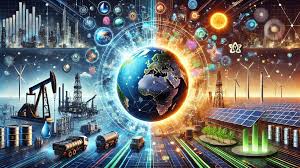
In a recent development, Ukrainian President Volodymyr Zelensky has signaled a willingness to collaborate with the United States to supply rare earth minerals, essential components in various high-tech industries. This move aligns with broader geopolitical strategies, as nations seek to secure critical resources amidst global tensions. The potential deal underscores the intricate relationship between energy resources and international diplomacy.
Geopolitical Energy Strategies
Energy policies are often crafted to align with a nation's geopolitical priorities. China's recent coal stockpiling efforts, for instance, reflect its focus on energy security in the face of global uncertainties. By amassing significant coal reserves, China aims to insulate itself from potential supply disruptions and price volatility in international energy markets. This strategy highlights the balancing act between maintaining energy security and adhering to global environmental commitments.
Despite global initiatives to reduce carbon emissions, coal remains a dominant energy source, particularly in rapidly developing economies. Economic factors, such as the affordability and abundance of coal, coupled with political considerations, often impede the transition to cleaner energy alternatives. The persistence of coal usage raises questions about the effectiveness of current climate policies and the challenges inherent in shifting away from established energy infrastructures.
Insights from Previous Energy Transitions
Historical energy transitions, such as the shift from wood to coal or from coal to oil, offer valuable lessons for today's move towards renewable energy. These past transitions were often gradual, influenced by technological advancements, economic incentives, and policy interventions. Understanding the drivers and barriers of previous shifts can inform current strategies to phase out fossil fuels and promote sustainable energy solutions.
Governments worldwide grapple with the tension between economic growth and environmental stewardship. Subsidies and policies that favor fossil fuel industries can undermine international climate agreements, leading to contradictions between stated environmental goals and actual energy practices. This dichotomy underscores the need for coherent policies that align economic incentives with sustainable development objectives.
Artificial Intelligence and Rising Energy Demand
The rapid advancement of artificial intelligence (AI) technologies has led to increased energy consumption, particularly in data centers that require substantial power to operate. While AI holds the promise of optimizing energy use across various sectors, its own energy footprint presents challenges. Balancing the benefits of AI with its energy demands necessitates innovative approaches to improve efficiency and integrate renewable energy sources into AI infrastructure.
Asia's Intensifying Coal Dependence
Countries in Asia, including China, India, Vietnam, and Indonesia, continue to prioritize coal to meet their growing energy needs. Factors such as rapid industrialization, economic development, and the relative cost-effectiveness of coal contribute to this trend. This reliance contrasts with the policies of many Western nations that are actively reducing coal consumption, highlighting regional disparities in energy strategies and environmental impacts.
Fluctuations in natural gas prices, exacerbated by geopolitical events like the Ukraine conflict, have led some countries to revert to coal as a more stable energy source. The volatility of natural gas markets poses challenges for nations attempting to transition to cleaner energy, as economic considerations often take precedence over environmental concerns. The future availability of liquefied natural gas (LNG) supplies may influence the balance between coal and gas in the global energy mix.
The transition to renewable energy is often hindered by outdated infrastructure and inefficiencies in energy transmission. In many regions, existing power grids are ill-equipped to handle the variable nature of renewable energy sources like wind and solar. Investments in modernizing grid infrastructure and enhancing energy storage capabilities are crucial to overcoming these barriers and facilitating a more resilient and sustainable energy system.
The Cost of Delayed Energy Transition
Prolonged dependence on coal and other fossil fuels carries significant long-term costs, including environmental degradation, public health issues, and economic liabilities associated with climate change. Regions that continue to rely heavily on coal often experience higher rates of respiratory illnesses and environmental pollution. Addressing these challenges requires comprehensive policies that account for the true costs of delayed energy transition and promote investments in cleaner alternatives.
Projections about the future of coal demand vary, with some analyses suggesting a peak before 2030, while others anticipate sustained usage driven by emerging economies. Policy shifts, technological innovations, and economic incentives will play pivotal roles in determining coal's place in the future energy landscape. A concerted effort to develop and deploy renewable energy technologies, coupled with supportive policies, could accelerate the decline of coal and foster a more sustainable global energy system.
The interplay between energy policies, geopolitical strategies, and economic considerations creates a complex landscape that nations must navigate to achieve both energy security and environmental sustainability. Learning from historical transitions, aligning economic incentives with climate commitments, and investing in infrastructure are essential steps toward a resilient and sustainable energy future.
(Source:www.cnbc.com)
Geopolitical Energy Strategies
Energy policies are often crafted to align with a nation's geopolitical priorities. China's recent coal stockpiling efforts, for instance, reflect its focus on energy security in the face of global uncertainties. By amassing significant coal reserves, China aims to insulate itself from potential supply disruptions and price volatility in international energy markets. This strategy highlights the balancing act between maintaining energy security and adhering to global environmental commitments.
Despite global initiatives to reduce carbon emissions, coal remains a dominant energy source, particularly in rapidly developing economies. Economic factors, such as the affordability and abundance of coal, coupled with political considerations, often impede the transition to cleaner energy alternatives. The persistence of coal usage raises questions about the effectiveness of current climate policies and the challenges inherent in shifting away from established energy infrastructures.
Insights from Previous Energy Transitions
Historical energy transitions, such as the shift from wood to coal or from coal to oil, offer valuable lessons for today's move towards renewable energy. These past transitions were often gradual, influenced by technological advancements, economic incentives, and policy interventions. Understanding the drivers and barriers of previous shifts can inform current strategies to phase out fossil fuels and promote sustainable energy solutions.
Governments worldwide grapple with the tension between economic growth and environmental stewardship. Subsidies and policies that favor fossil fuel industries can undermine international climate agreements, leading to contradictions between stated environmental goals and actual energy practices. This dichotomy underscores the need for coherent policies that align economic incentives with sustainable development objectives.
Artificial Intelligence and Rising Energy Demand
The rapid advancement of artificial intelligence (AI) technologies has led to increased energy consumption, particularly in data centers that require substantial power to operate. While AI holds the promise of optimizing energy use across various sectors, its own energy footprint presents challenges. Balancing the benefits of AI with its energy demands necessitates innovative approaches to improve efficiency and integrate renewable energy sources into AI infrastructure.
Asia's Intensifying Coal Dependence
Countries in Asia, including China, India, Vietnam, and Indonesia, continue to prioritize coal to meet their growing energy needs. Factors such as rapid industrialization, economic development, and the relative cost-effectiveness of coal contribute to this trend. This reliance contrasts with the policies of many Western nations that are actively reducing coal consumption, highlighting regional disparities in energy strategies and environmental impacts.
Fluctuations in natural gas prices, exacerbated by geopolitical events like the Ukraine conflict, have led some countries to revert to coal as a more stable energy source. The volatility of natural gas markets poses challenges for nations attempting to transition to cleaner energy, as economic considerations often take precedence over environmental concerns. The future availability of liquefied natural gas (LNG) supplies may influence the balance between coal and gas in the global energy mix.
The transition to renewable energy is often hindered by outdated infrastructure and inefficiencies in energy transmission. In many regions, existing power grids are ill-equipped to handle the variable nature of renewable energy sources like wind and solar. Investments in modernizing grid infrastructure and enhancing energy storage capabilities are crucial to overcoming these barriers and facilitating a more resilient and sustainable energy system.
The Cost of Delayed Energy Transition
Prolonged dependence on coal and other fossil fuels carries significant long-term costs, including environmental degradation, public health issues, and economic liabilities associated with climate change. Regions that continue to rely heavily on coal often experience higher rates of respiratory illnesses and environmental pollution. Addressing these challenges requires comprehensive policies that account for the true costs of delayed energy transition and promote investments in cleaner alternatives.
Projections about the future of coal demand vary, with some analyses suggesting a peak before 2030, while others anticipate sustained usage driven by emerging economies. Policy shifts, technological innovations, and economic incentives will play pivotal roles in determining coal's place in the future energy landscape. A concerted effort to develop and deploy renewable energy technologies, coupled with supportive policies, could accelerate the decline of coal and foster a more sustainable global energy system.
The interplay between energy policies, geopolitical strategies, and economic considerations creates a complex landscape that nations must navigate to achieve both energy security and environmental sustainability. Learning from historical transitions, aligning economic incentives with climate commitments, and investing in infrastructure are essential steps toward a resilient and sustainable energy future.
(Source:www.cnbc.com)





